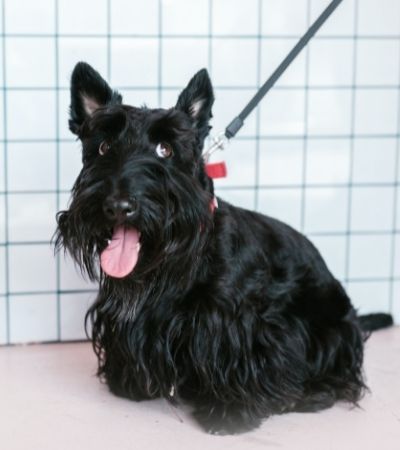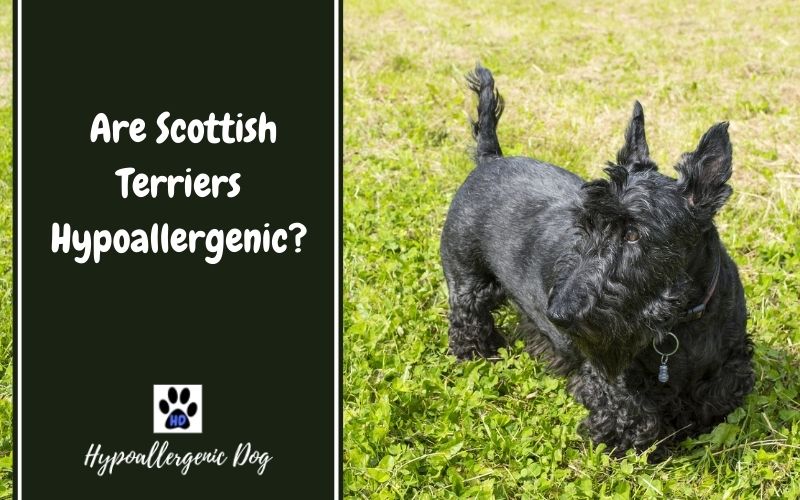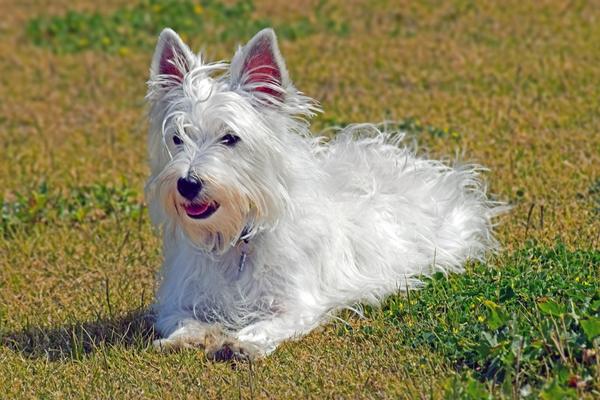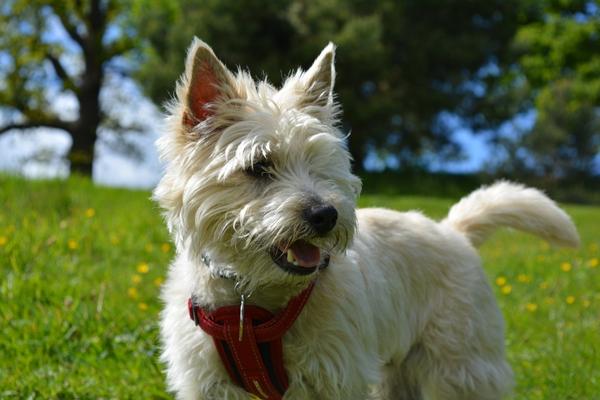Are Scottish Terriers Hypoallergenic?
Yes! The Scottish Terrier is a small hypoallergenic dog breed that hardly ever sheds or drools.
![]()
![]()
![]()
![]()
If you’re looking for a spirited sidekick with an attitude problem, the Scottish Terrier might be the dog for you! These short little spitfires are like any proper Scot and have fiery tempers.
Low-shedding and low-drooling, Scottie dogs are ideal for allergy sufferers, and these characteristics are what make them hypoallergenic. They’re also about average when it comes to their grooming needs, another huge plus for these feisty little tail-waggers.
Scotties are so cute they actually inspired a whole fashion movement in the US. You know the plaid/tartan look girls loved in the 90s? The one that always featured a squat, foxy-eared black dog with a beard? Yep, that’s a Scottish Terrier.
Scottish Terrier Quick Facts

Scottish Terriers have a short and stocky appearance — short legs and really low to the ground. When their coats are cut in the “fancy style” they look like black brooms with a dog face! Speaking of their face, Scottish Terriers have scruffy, bushy eyebrows, and a wiry beard — the feature that they’re likely most famous for. These Terriers also have stubby, serious-looking tails that either stick straight up or curve slightly over their body.
Scottish Terrier’s Coat
Similar to other Terrier breeds, the Scottie’s coat has a wiry texture and grows to a medium length. They also have a double coat, the top fur is harsh and wiry to the touch, and the undercoat is made up of dense and soft fur. Black Scotties are the most popular, but you can find them in various other colors — white, wheaten, brindle, or gray.
Scottish Terrier — Height and Weight
The Scottie isn’t a big dog, so if you’re looking for a small companion, size-wise they’re a good fit. They only reach heights of around 10 inches and weigh between 18-22 pounds.
Scottish Terrier Temperament
Scotties are intelligent and dignified dogs. They have high energy levels, like many of their canine cousins, but are far too mature to goof around. The Scottish Terrier is said to have a human-like personality, with the strong-willed Terrier temperament mixed in for good measure.
While likely to be aloof around strangers, they’re loyal and protective of their family. If you want a strong-willed watchdog — get a Scottie!
Best suited to a firm but fair owner, Scotties may push the boundaries and ignore the house rules. Early socialization and effective training methods are essential to keep your Terrier in line.

Are You Considering Getting a Scottish Terrier?
Here’s what to watch out for :
- They’re not a good choice for first-time dog owners.
- You absolutely have to socialize them and train them for obedience when they’re puppies, or you run the risk that they’ll be aggressive with other dogs when they’re older.
- Scotties are in the “challenging to train” dog category. They’re super stubborn, very independent, and will hold it against you if you lose your temper. They have a mind of their own, for sure.
- I should probably add that you can’t trust a Scottish Terrier off-leash, either.
- Because of their philosophy — the best defense is a good offense — these guys really aren’t great dog park puppies. They need a lot of exercise though, so you need to have other ways of satisfying their drive.
- They treat all house guests as potential robbers and murderers. Scotties allow a guest to enter their home, but they will eye them suspiciously the entire time. Honestly, they have kind of dark, satirical personalities.
- Scottish Terriers are intelligent, but they can be kind of like cats. They know what you want, but they’re just declining the invitation to do it. And, because they’re really smart, you still have to find ways to challenge their brain, or they will get bored and make their own games….at your expense.
- Scotties are NOT great with crates. You should teach them to deal with it, but you can’t just leave a Scottie crated for hours on end.
- You know the expression sink or swim? Scotties sink, they don’t swim.….like, in a literal sense.
- Scottish Terriers love to dig, so say goodbye to that beautiful tomato garden you just planted.
Ask anyone who owns a Scottish Terrier, and they’ll tell you that these dogs can be headstrong. They’re also extremely intelligent, but their big brains sometimes cause problems. And, combine this with their independent side — when they decide to go ‘full Terrier mode,’ training can be challenging, to say the least.
However, don’t worry! It is possible to train the Scottie to be a well-socialized and well-behaved canine companion. The key is to keep training sessions short, fun, and engaging. Try not to spend more than 15 minutes at a time, and remember to mix up your techniques and activities.
While your Scottie will appreciate a fun and varied training regime, patience and praise should always be used. Scottish Terriers will not appreciate being yelled at. Instead, remain calm and use plenty of positive reinforcement when they do things right.
Scottish Terrier Exercise Needs
As intelligent dogs, Scotties can swiftly become bored and get themselves into mischief. So, to keep your pooch out of trouble, make sure you walk them every day.
Scottish Terriers don’t need to be out for long, 20 to 40 minutes is ample. This breed prefers a brisk walk around the block, instead of a long hike or jog with their owner.
As well as exercising their body, you’ll need to keep your Scottie’s brain stimulated too. They love to play chase, so chucking a ball or dog toy around for them is perfect.

Maintaining Your Scottish Terrier’s Coat
Their perfectly trimmed eyebrows and beard have to be the Scotties’ hallmark feature. Their silhouette is famous, and this look can only be achieved with a regular grooming schedule.
First, the coat. As Scotties have a double coat, they need to be brushed regularly to remove any shed fur from between the layers. To keep the wiry coat healthy and tangle-free, brushing it once a week is a must.
Hand-stripping is the ideal way to keep your Scottie’s coat neat and tidy. This technique must be introduced during the puppy days, and it can be a tricky skill to master. Hence, many Scottish Terrier owners will opt for a professional clipping — every six to 8 weeks — over hand-stripping, but in time this can cause the coat to lose its natural wiry texture.
What Makes a Scottish Terrier Hypoallergenic?
They hardly shed or drool. But that little beard may need some attention — it can pick up all sorts.
Dog allergies are generally sparked off by dander and/or saliva, so Scotties shouldn’t cause any issues. That said, everyone is different, and you’ll need to meet the breed in person before making a final decision.
If you neglect your Scottie’s grooming routine, you may start to notice an increase in your allergy symptoms. It’s important to brush out all of the fur and dander in your dog’s coat, this will stop the allergens from spreading around your home and causing problems.
Teeth, Ears, and Nails
The Scottish Terrier has adorable pointy ears and you mustn’t forget to clean them regularly. Scotties will need excess hair removed from the inside to prevent ear infections. You don’t need to do this regularly, but try to be conscious of how much hair is puffing out of those cute little ears.
It’s also important to look after your dog’s teeth. Always use a canine-friendly toothpaste and brush your Scottish Terrier’s teeth two or three times a week.
Scotties will need their nails trimmed approximately every 2 weeks. A good sign that it’s time is if their nails are making contact with the ground when your pooch is walking. If you’re nervous about clipping your Scottie’s nails, a professional groomer will be able to get the job done for you.
- Lens Luxation.
- Hypersensitivity to environmental allergies.
- Cataracts.
- Deafness.
- Von Willebrand’s Disease.
- Cushing’s Syndrome.
Conclusion
The independent and spunky Scottish Terrier can be hard to train, but they’re worth the effort. Scotties are intelligent and dignified, and form strong and loyal bonds with their owners.
This breed has a lot of energy but will only need one brisk walk a day. What’s more, these pooches love to play and will be your best friend if you throw them a ball to chase.
With their wiry, double coat and low dander levels, this breed is an awesome choice for people with allergies. So, if you’ve been wondering, are Scottish Terriers hypoallergenic? You now have the answer.
Do Scottish Terriers Shed?
Do Scottish Terriers shed a lot? Nope. They hardly shed at all. And, when the Scottie does lose fur, it becomes trapped between the two layers of their double coat. So, regular weekly brushing is a must-do job.
Do Scottish Terriers Bark a Lot?
Yes. These dogs are loyal and have a strong desire to protect their family. They make excellent watchdogs but can be a little too eager to ‘talk.’ Plus, it’s not uncommon for a Scottie to bark when they’re bored and feeling under-stimulated.
Are Scottish Terriers Good for Allergy Sufferers?
Without a doubt. Scottish Terriers hardly shed any fur. They aren’t drooly dogs either, so won’t spread allergens through excess saliva. However, no dog is 100% allergy-free, so try to spend time with a Scottie before deciding to welcome one into your home.
Are Scottish Terriers Good With Kids?
With training.
The Scottie can be a fun dog for older kids because they’re robust and enthusiastic. That said, they’re powerful pooches — they can pull a kid right off their feet. They’re also rough when they play, and they’ll get an attitude about being pushed, pulled, or otherwise poorly treated. You need to socialize them with a lot of little people when they’re still a puppy, and they’re really not great dogs for young ones under the age of seven.
Are Scottish Terriers Good Family Dogs?
Scottish Terriers can get on well in a family setting, but early socialization and training are a must. They can be too feisty and rough for young children, and too energetic to be considered a lap dog. But, if you have the time and patience to properly train your Scottie, this breed will be a loyal companion for all the family.
Is the Scottish Terrier Good for Apartments?
Yes. Their small size means that apartment complexes that allow dogs are more likely to accept them. They also adjust well to living in smaller spaces, provided they’re well-exercised and mentally stimulated, as they’re known to be barkers.
What Are the Scottish Terrier Pros and Cons?
Pros
- Extremely intelligent.
- Loves to play.
- Hypoallergenic.
- Low maintenance.
Cons
- Can be standoffish around strangers.
- Not afraid to argue with another dog.
- Can be difficult to train.
- They will rule the house if you let them
| Breed | Scottish Terrier |
| Other Names? | Scottie / Aberdeen Terrier |
| Hypoallergenic? | Yes |
| Height | 10 inches |
| Weight | (male) 19 – 22 pounds (female) 18 – 21 pounds |
| Lifespan | 12 years |
| Temperament | Intelligent, spirited, confident, independent, loyal, energetic, stubborn, dignified, aloof, affectionate, playful |
| Colors | Black, brindle, wheaten, silver/black/red brindle |
| Coat | Medium, wiry, double coat |
| How much grooming? | Medium / low maintenance — weekly brushing needed, hand stripping preferred |
| How much shedding | Very low |
| Dander levels | Low |
| Saliva–Drooling and licking frequency? | Low |
| Energy levels | High-energy breed |
| How much exercise do they need? | 20 – 40 minute brisk walk daily |
| Health problems | Prone to deafness, cataracts, Cushing’s disease |
| Good for apartment? | Yes — but needs daily time outdoors too |
| Suitable for kids? | Better with children over 7 years old |
| How much do they bark? | Vocal |
| Can they be left alone? | Happy to be alone for 4 – 8 hours |
| Intelligent? | Clever and independent |
| Trainable? | Can be difficult to train — stubborn at times |
| How popular as a pet? | Popular (Ranked 58th in AKC’s most popular breeds list) |
| Any other important facts? | Scottish Terriers were originally bred as ‘ratters.’ Scotties would also go up against badgers and other large vermin. As loyal pets today, Scottish Terriers still have a strong prey drive and will chase after small animals if given the chance. |





